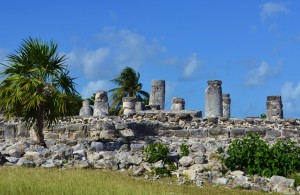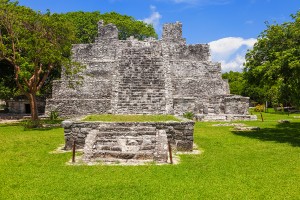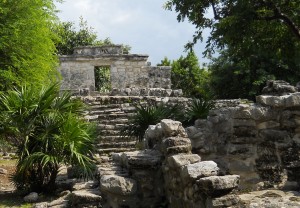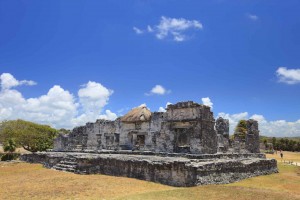With the seemingly endless multitude of Mayan ruins that adorn the Riviera Maya, the humbling abundance of history that lies littered along its coastline, there is no shortage of opportunities to explore the remnants of that long-long civilization.
Certainly with UNESCO sites such as Tulum, Coba and Chichen Itza all within driving distance, it can be tempting spend your valuable vacation time locked inside a tour bus or negotiating Mexican road signs in your rental car. But with so many well-preserved ruins within the parameters or in a short distance of the tourist centre of Cancun, there is no need to venture too far to capture a glimpse of the rich history for which the region is famed.
 El Rey
El Rey
Located in the very heart of Cancun’s buzzing hotel district, the ruins at El Rey should be the first stop for any Cancun-based history-hunter. This was the place where archaeologists unearthed one of the most celebrated of Mayan artifacts; a huge ceremonial mask that is still retains much of its mysteries even today. With 47 stone monuments dotted around the small but densely decorated site, it is possible to wander around for some time simply soaking in the centuries-crafted atmosphere. But be sure to watch your step. Besides the lingering spirits of its Mayan inhabitants, El Rey is also home to hundreds upon hundreds of iguanas who spend their daylight hours sunning themselves and awaiting their ever-popular photo opportunities.
 El Meco
El Meco
Not far away, only a few kilometres from the centre of Cancun, lies the oft-overlooked ruins at El Meco. This hidden gem was at its peak during the third century and then again in the eleventh and today it offers a fine example of a Castillo pyramid, a towering structure that permits guests marvellous views of the comings and goings of ships in the nearby harbour. Although there are no tours that make the trip to El Meco, this should not deter prospective visitors. Free from the rabble of tourists, El Meco possesses a serenity that allows you to recreate the sense of discovery those first explorers must have had as they battled their way through the undergrowth and into this this ancient world.
 Xcaret
Xcaret
Travel only a few kilometres down the coastline and you will encounter Xcaret, ruins that lay within the ecological park of the same name. The settlement, which had a dazzlingly rich history all the way up to the arrival of the Spanish in the early 15th century, is an excellent choice for those who want to experience all facets of Mayan life without travelling far and, with opportunities for swimming and interactive replicas of original village life, the site is unsurprisingly popular with children. Nevertheless, it must also be noted that the nightly performances of Mayan rituals know no age limit.
 Xel-Ha
Xel-Ha
Hidden away amongst the dense forest vegetation, a visit to Xel-Ha really is a journey back into recesses of the region’s history. This very secluded setting is a fine example of the resilience of Mayan architecture, the walls of the settlement still etched with work of long gone artists. Although most of these murals are faded now, it is still possible to define the images of the Gods and Goddesses that, to the ancient Mayan, were responsible for the coming of the seasons and the success of their crops and still it remains a fitting tribute to these forgotten deities. The flora on display presents to visitors an ever-changing kaleidoscope of colours and with a nearby cenote shimmering invitingly, it is a good idea to pack your swimming gear.